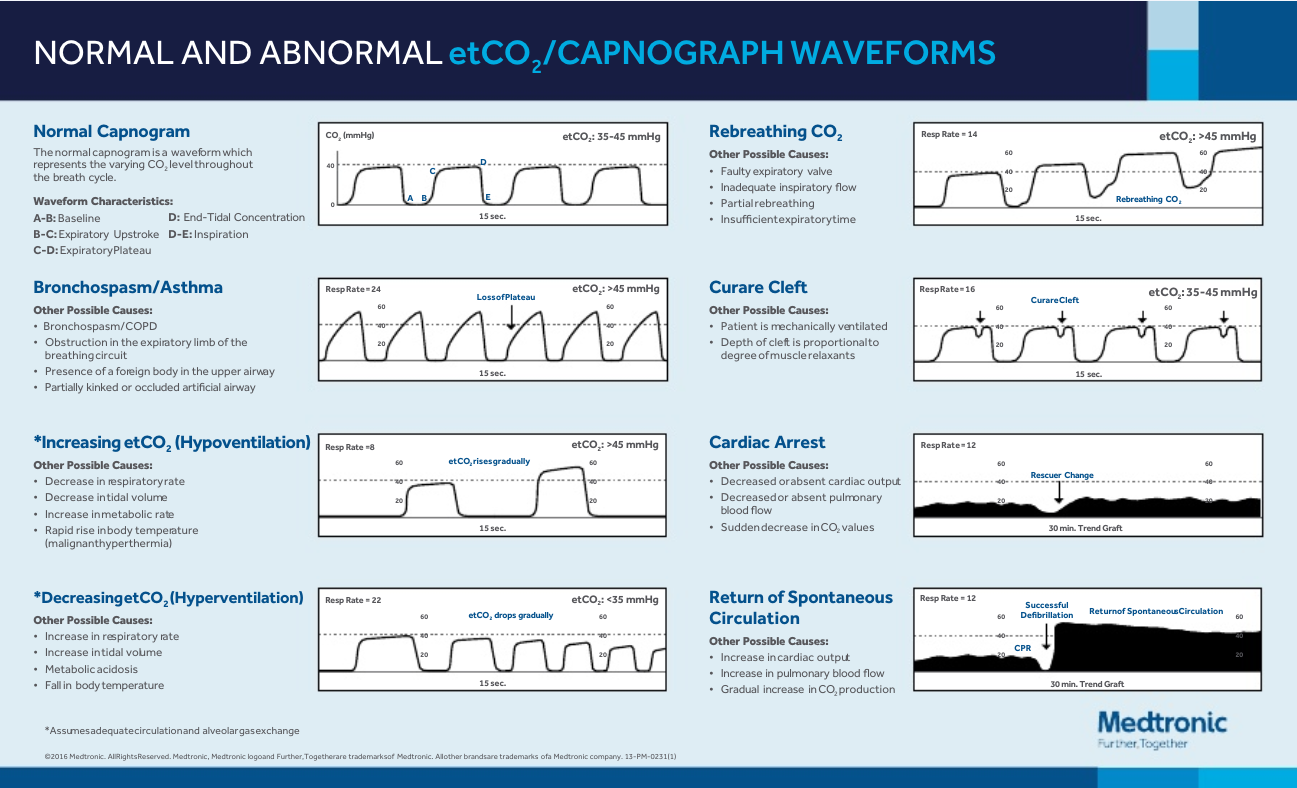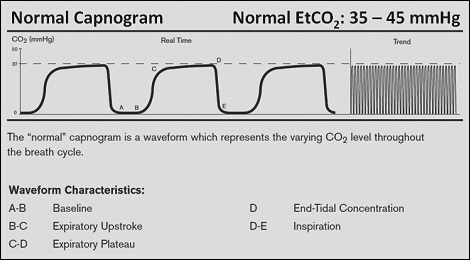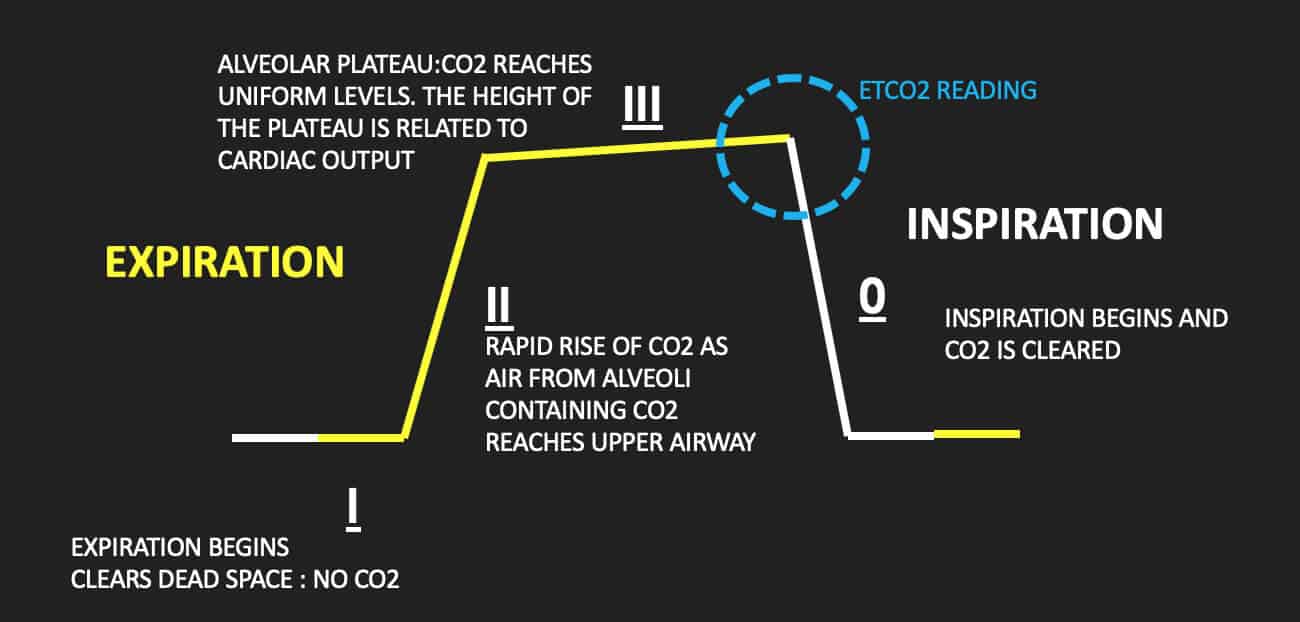normal end tidal co2 levels
The height of the capnography waveform accompanies this number on the monitor as well as the. Savastano S et al.
Riding The Wave Of Capnography Understanding Etco2 Vetbloom Blog
We experimentally examined the reliability of ETCO2 measurements through a nasal cannula and found that they depended on both biological factors tidal volume and respiratory rates and mechanical factors the diameter and the.

. In fact its commonly called the ventilation vital sign. Levels of end-tidal carbon dioxide are low despite normal respiratory rate in individuals with long COVID. SS-ETCO2 measurement and arterial blood gas analysis were carried out on 118 patients.
The level of CO 2 gradually rises during exhalation showing an approximate equalization with the CO 2 value in alveoli in the lungs hence the phrase end-tidal. Ganong 1995 or partial pressure of 53 of normal air at sea level. 2 LEVELS 8 If EtCO2 level is lowundetectable can be explained by 1 pulmonary blood flow is low largemassive PE 2 pulmonary exhaled air is low status asthmaticus 3 poor offloading of C02 to lungs pulmonary edema NaHC03 will increase EtCO2 because it splits into CO2 and H20 So if rises after NaHCO3 do not misinterpret as ROSC.
End-tidal carbon dioxide ETCO2 is the level of carbon dioxide that is released at the end of an exhaled breath. End-tidal carbon dioxide and defibrillation success in out-of-hospital cardiac arrest. So the short answer is you are right about the ranges 35-45 but that is for actual PaCo2 drawn from an ABG.
Capnography waveforms etCO2 and breathing patterns. MONITORING of end-tidal carbon dioxide is one of the most important means of determining the physiologic well-being of anesthetized patients. End-tidal CO2 EtCO2 monitoring is a noninvasive technique which measures the partial pressure or maximal concentration of carbon dioxide CO2 at the end of an exhaled breath which is expressed as a percentage of CO2 or mmHg.
The normal values are 5. End tidal Co2 ranges vary slightly from actual PaCo2 and can be affected by many factors depending on the condition of the patients lungs. The amount of CO2 at the end of exhalation or end-tidal CO2 ETCO2 is normally 35-45 mm HG.
End-tidal capnography or end-tidal CO2 EtCO2 monitoring is a non-invasive technique that measures the partial pressure or maximal concentration of carbon dioxide CO2 at the end of an exhaled breath. Many things must occur for the exhaled carbon dioxide tracing to appear normal fig. For this reason the accuracy of the partial pressure of end-tidal carbon dioxide ETCO2 measurements is questionable.
Since problems with lungs are not common and gas exchange between alveoli and the blood is swift and effective. For a person with normal lungs the difference between end tidal and Paco2 can vary between 5-8mmHg depending on the book your reading. Can the value of end tidal CO2 prognosticate ROSC in patients coding into emergency department with an out-of-hospital cardiac arrest.
Also called capnometry or capnography this noninvasive technique provides a breath-by-breath analysis and a continuous recording of ventilatory status. Levels of end-tidal carbon dioxide are low despite normal respiratory rate in individuals with long COVID J Breath Res. Mean arterial PCO2 levels were 43241473 and mean ETCO2 levels were 34231086 mmHg.
The normal range for CO2 in your blood is 23 to 29 mEqL. Measuring End Tidal CO2 Daltons Law. End-tidal carbon dioxide ETco 2 monitoring provides valuable information about CO 2 production and clearance ventilation.
Capnography monitoring as a clinician tool to help enhance patient care is used in multiple environments from the emergency room ER to the ICU. End-tidal carbon dioxide ETCO2 is the level of carbon dioxide that is released at the end of an exhaled breath. Levels of end-tidal carbon dioxide are low despite normal respiratory rate in individuals with long COVID.
Available evidence has established that ETCO2 measurement can provide an indication of cardiac output and pulmonary blood flow24 Non. For a person with normal lungs the difference between end tidal and Paco2 can vary between 5. Capnography can be used to measure end-tidal CO 2.
The Difference Between Arterial and End Tidal CO2. 123 In this article we discuss the key facts in understanding this technology and its implications in clinical practice. ETCO2 levels reflect the adequacy with which carbon dioxide CO2 is carried in the blood back to the lungs and exhaled.
The normal values are 5 to 6 CO2 which is equivalent to 35-45 mmHg. Agreement between PCO2 and ETCO2 measurements was 84 mmHg and a precision of 111 mmHgAs there is only a moderate correlation between PCO2 and ETCO2 levels in COPD. In conditions of normal breathing 6 Lmin 12 breathsmin 500 ml for tidal volume etCO 2 is very close to alveolar CO2.
The normal alveolar CO 2 pressure is about 40 mm Hg pressure Guyton 1984. Sometimes the normal levels of CO2 may also depend upon the range set by a certain laboratory how the test is administered and the kind of medication an individual is taking. The level of carbon dioxide that is released at the end of an exhaled breath is called End Tidal CO 2 ETCO 2 and it reflects the patients ventilatory status.
According to age the normal CO2 level of an individual aging 18 to 59 years old is from 23 to 29 mEqL. To maximize the benefits of capnography a solid knowledge of all aspects of capnography measurements is required. The amount of CO2 at the end of exhalation or end-tidal CO2 ETCO2 is normally 35-45 mm HG.
Exhaled carbon dioxide both in terms of its quantity and pattern provides detailed information on the cardiopulmonary system. End tidal CO 2 monitoring is represented as a number and a graph on a monitor.

Normal And Abnormal Capnography Waveforms Infographic Capnoacademy Capnoacademy

Quantitative Waveform Capnography Acls Medical Training

Basic Capnography Interpretation Nuem Blog

The Impact Of Ventilation Rate On End Tidal Carbon Dioxide Level During Manual Cardiopulmonary Resuscitation Resuscitation

Waveform Capnography In The Intubated Patient Emcrit Project

Exhaled Carbon Monoxide End Tidal Co2 And Peripheral Oxygen Saturation Download Table

Waveform Capnography In The Intubated Patient Emcrit Project
The Normal Capnograph Waveform Deranged Physiology

Average Etco2 Kpa During Cpr In Patients With Or Without Rosc Download Scientific Diagram
End Tidal Co2 Monitoring In The Pre Hospital Environment More Than Just Endotracheal Tube Placement Confirmation Journal Of Paramedic Practice

Capnogram R Series Defibrillator Zoll Medical Uk

Waveform Capnography In The Intubated Patient Emcrit Project

Figure 1 From Applications Of End Tidal Carbon Dioxide Etco2 Monitoring In Emergency Department A Narrative Review Semantic Scholar
Emdocs Net Emergency Medicine Educationcapnography In The Ed Emdocs Net Emergency Medicine Education

Capnography Provides Bigger Physiological Picture To Maximize Patient Care Jems Ems Emergency Medical Services Training Paramedic Emt News

End Tidal Capnography Can Be Useful For Detecting Diabetic Ketoacidosis Monitoring Copd Acep Now

End Tidal Co2 And Transcutaneous Monitoring

Exhaled Carbon Monoxide End Tidal Co2 And Peripheral Oxygen Saturation Download Table
